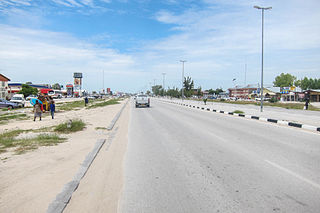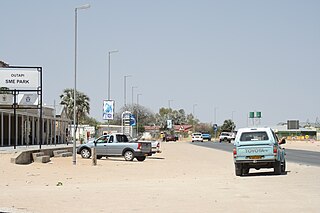
Omusati is one of the fourteen regions of Namibia, its capital is Outapi. The towns of Okahao, Oshikuku and Ruacana as well as the self-governed village Tsandi are situated in this region. As of 2020, Omusati had 148,834 registered voters.

Ondangwa is a town in the Oshana Region of northern Namibia, bordering the Oshikoto Region. Ondangwa was first established as a mission station of the Finnish Missionary Society in 1890. In 1914, it became a local seat of government.

Outapi wa Nakafingo na Temba, also Outapi or Uutapi and Ombalantu, is a town in northern Namibia near the border with Angola, situated 90 km (56 mi) northwest of Oshakati. It is the capital of the Omusati region and the district capital of the Outapi electoral constituency. It had a population of 13,664 people in 2023. The language spoken there is Oshiwambo.
Eenhana is the capital town of the Ohangwena Region, northern Namibia, on the border with Angola. It also used to be a mission station of the Finnish Missionary Society. It had a population of 16,588 people in 2023.

Ongwediva is a town in the Oshana Region in the north of Namibia. It is the district capital of the Ongwediva electoral constituency. As of 2023 it had 28,000 inhabitants and covered 4,102 hectares of land. Ongwediva has seven churches, two private schools and 13 government-run schools. Most of the inhabitants speak Oshiwambo.
Nkurenkuru is a town on the south-western banks of the Kavango River. It is the capital of the Kavango West Region of northern Namibia, located 140 kilometres (87 mi) west of Rundu. It is also a former mission station of the Finnish Missionary Society.
Oshikuku is a town in Omusati Region in the north of Namibia. It is the district capital of Oshikuku Constituency. It had a population of 5,499 people in 2023.
Okahao is a town in the Omusati Region of northern Namibia and the district capital of the Okahao electoral constituency which is the largest constituency in Omusati region in terms of area. It is a former mission station of the Finnish Missionary Society. Okahao had a population of 7,486 people in 2023.

Outapi Constituency is an electoral constituency in the Omusati Region of Namibia on the border of Angola. It had 30,313 inhabitants in 2004 and 23,516 registered voters in 2020. Its district capital is the town of Outapi.

Martti (Martin) Rautanen was the pioneer of the Finnish Mission in Ovamboland, South West Africa.
Karl Emil Liljeblad was a Finnish pastor, vicar, missionary and educator, and during his final years, a researcher in Folkloristics.

The Finnish Evangelical Lutheran Mission is a Lutheran missionary society formed on January 19, 1859, in Helsinki, Finland. It is one of seven organisations of the Evangelical Lutheran Church of Finland (ELCF) that conduct missionary work. Its first deployments outside Finland were made to Ovamboland, an area that today is cut by the Angola-Namibian border.
Nakayale, also known as Nakayale Keengulu is a village in northern Namibia near Outapi in Omusati Region situated 86km northwest of Oshakati and 4km from Outapi. It is in Anamulenge Constituency.
Omandongo is a populated place in the Onayena Constituency in the Oshikoto Region in northern Namibia, and the region which used to be called Ovamboland.
Engela is an Ovambo settlement in the Ohangwena Region in northern Namibia. Formerly situated in the Oukwanyama area it is since 2004 part of the town Helao Nafidi, although it still maintained its own village council until the 2015 local authority election. It is one of the more important establishments of the Evangelical Lutheran Church in Namibia (ELCIN) in the area. It started as a mission station of the Finnish Missionary Society. Today, it is the centre of the Engela Constituency.
Anamulenge is a settlement and former Catholic mission station in the Omusati Region in the north of Namibia in the Ombalantu tribal area. It is the centre of the Anamulenge Constituency.
Simson Teteinge Haivela Shituwa was one of the first seven Ovambo pastors, whom the director of the Finnish Missionary Society, Matti Tarkkanen ordained into priesthood in Oniipa, Ovamboland, on 27 September 1925, with a permission granted by the Bishop of Tampere, Jaakko Gummerus.
Nangombe Sakeus Iihuhua was one of the first seven Ovambo pastors, whom the director of the Finnish Missionary Society, Matti Tarkkanen ordained into priesthood in Oniipa, Ovamboland, on 27 September 1925, with a permission granted by the Bishop of Tampere, Jaakko Gummerus. His brother Obadja Iihuhua was also ordained at the same time.
Uushunga Obadja Iihuhua was one of the first seven Ovambo pastors, whom the director of the Finnish Missionary Society, Matti Tarkkanen ordained into priesthood in Oniipa, Ovamboland, on 27 September 1925, with a permission granted by the Bishop of Tampere, Jaakko Gummerus. His brother Sakeus Iihuhua was also ordained at the same time.

Namibia held elections for their local and regional councils on 27 November 2015. Ballots were cast using electronic voting.








